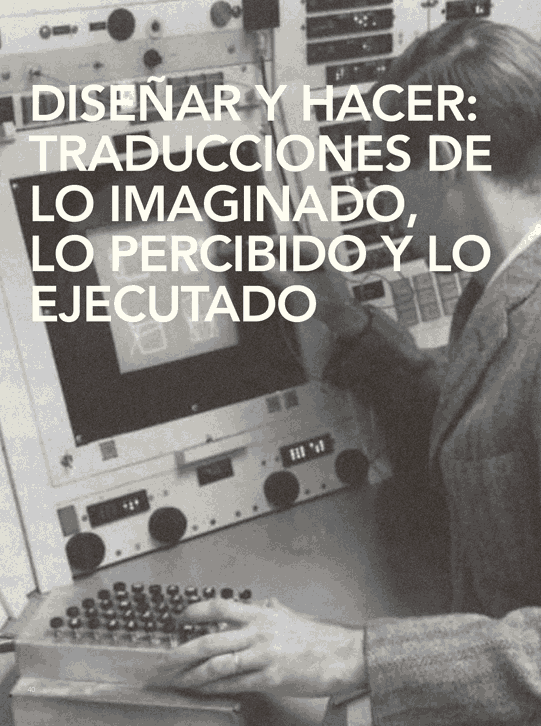Diseñar y hacer: Traducciones de lo imaginado, lo percibido y lo ejecutado
Article Sidebar

Keywords:
Main Article Content
Abstract
Según Schön (1987), el diseño es una forma de arte y de producción, donde el aprender acerca de un tema o diseño específico surge a través de acciones (conscientes o inconscientes) y operaciones heurísticas. El diseñador aprende a diseñar sabiendo y “reflexionando en acción”, reinterpretando y re-elaborando acciones en el momento especial en que tiene lugar el acto de diseñar (Schön, 1987). Esto permite que surjan no sólo nuevos significados y coherencias, sino también la razón y el conocimiento del acto creativo. Este artículo presenta la perspectiva optimista de los primeros proponentes de CAD a comienzos de la década de los sesenta, quienes apoyados por la cibernética y las teorías de la inteligencia artificial, tenían como objetivo principal el desarrollo de “potenciadores de la creatividad”. Esta visión contrasta con el panorama del diseño digital contemporáneo, que discute la relevancia, la pertinencia y el uso actual de lo digital con respecto a lo material. Finalmente, revela aspectos clave de las numerosas interpretaciones de lo imaginado, lo percibido y lo ejecutado, identificando problemas y nuevas alternativas para el uso creativo de lo que actualmente es ubicuo y genérico en términos de destrezas disponibles para los arquitectos.
Abstract
According to Schön (1987), design is a form of artistry and making, where learning about a specific topic or design emerges through actions (conscious and unconscious) and heuristics. The designer learns how to design by knowing and ‘reflecting in action’, reinterpreting and re-elaborating actions in the particular moment where the act of design takes place (Schön, 1987). This allows the emergence of not only new meanings and coherences, but also reason and knowledge about the creative act. This article presents the optimistic perspective of early CAD proponents in the early 60s that, supported by cybernetic and Artificial Intelligence theories, had as main goal the development of ‘creative enhancers’. This vision is contrasted to the contemporary digital design scenario, discussing the relevance, pertinence and current use of the digital towards the material. Finally, it reveals key aspects of the myriad translations between the imagined, the perceived and the executed, identifying problems and new alternatives for the creative use of what today is ubiquitous and generic in terms of skills available for architects.
Article Details
Materia Arquitectura provides immediate and free access to all the content of this online edition, published simultaneously with the print edition.
Materia Arquitectura does not charge authors for any concept.
All contents of this electronic edition are distributed under the Creative Commons license of "Attribución-shareAlike 4.0 Internacional" (CC-BY-SA).
The rights of the published texts and images belong to their authors, who grant Materia Arquitectura the license for their use. The management of the permits and the authorization of the publication of the images (or of any material) that contains copyright and its consequent rights of reproduction in this publication is the sole responsibility of the authors of the articles.
As long as they mention their origin, the authors are free to distribute their articles by other means. Any total or partial reproduction of the material must mention its origin.
Downloads
References
BAZJANAC, V. (1975). The Promises and the Disappointments of Computer-Aided Design. En N. Negroponte (Ed.), Reflections on Computer Aids to Design and Architecture (págs. 17-26). Nueva York, NY, EE.UU.: Petrocelli/Charter.
COONS, S. (1975). Reflections beyond SKETCHPAD. En N. Negroponte (Ed.), Reflections on Computer Aids to Design and Architecture (págs. 27-29). Nueva York, NY, EE.UU.: Petrocelli/Charter.
KOLAREVIC, B. (Ed.). (2003). Introduction. En B. Kolarevic (Ed.), Architecture in the digital age: Design and manufacturing (págs. 1-16). Nueva York, NY, EE.UU.: Spon Press.
MILNE, M. (1975). Whatever Became Of Design Methodology? En N. Negroponte (Ed.), Reflections on Computer Aids to Design and Architecture (págs. 30-36). Nueva York, NY, EE.UU.: Petrocelli/Charter.
NEGROPONTE, N. (1975). Introduction. En N. Negroponte (Ed.), Reflections on Computer Aids to Design and Architecture (págs. 1-13). Nueva York, NY, EE.UU.: Petrocelli/Charter.
OXMAN, R. (2006). Theory and design in the first digital age. Design Studies, 27(3), 229–265.
ROBINSON, D. (2013). Feeling extended: Sociality as extended body-becoming-mind. Cambridge, MA, EE.UU.: MIT Press.
SCHÖN, D. A. (1987). Educating the reflective practitioner. San Francisco, CA, EE.UU.: Jossey-Bass.
SUTHERLAND, I. (1975). Structure in drawings and the hidden surface problem. En N. Negroponte (Ed.), Reflections on Computer Aids to Design and Architecture (págs. 73-77). Nueva York, NY, EE.UU.: Petrocelli/Charter.
VISSER, W. (2006). The cognitive artifacts of designing. Mahwah, NJ, EE.UU.: L. Erlbaum Associates.
Most read articles by the same author(s)
- Diego Pinochet, Design and Make: Translations between the Imagined, the Perceived and the Executed , Materia Arquitectura: No. 13 (2016): Materia Arquitectura 13 (Agosto/August 2016)